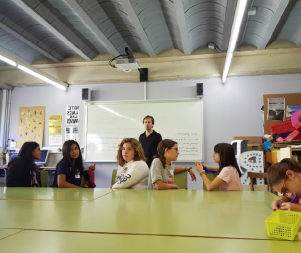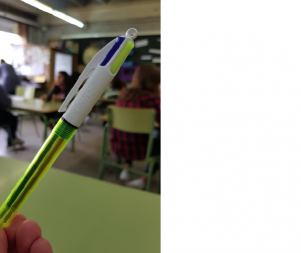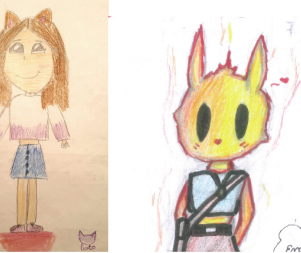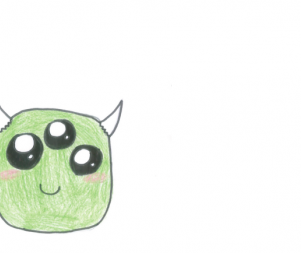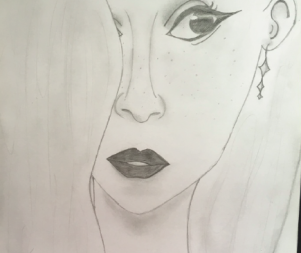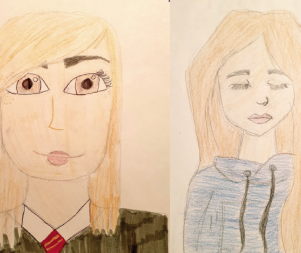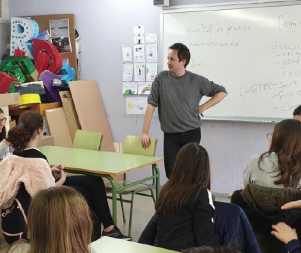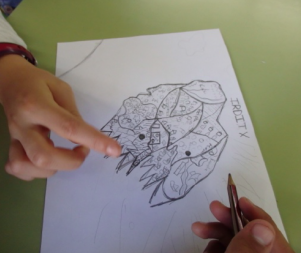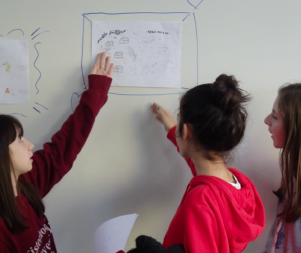- 14th EDITION 2022 / 2023
- 13th EDITION 2021 / 2022
- 12th EDITION 2020 / 2021
- 11th EDITION 2019 / 2020
- 10th EDITION 2018 / 2019
- 9th EDITION 2017 / 2018
- 8th EDITION 2016 / 2017
- 7th EDITION 2015 / 2016
- 6th EDITION 2014 / 2015
- 5th EDITION 2013 / 2014
- 4th EDITION 2012 / 2013
- 3rd EDITION 2011 / 2012
- 2nd EDITION 2010 / 2011
- 1st EDITION 2009 / 2010
Max Besora IN RESiDENCE at the School Doctor Puigvert
Landing
Students prepared the meeting with Max Besora by researching his work, recording his recitals and coming up with questions to ask him on the first day. Max presented them with a “power object”, which they would work with throughout the residence.
October, November and December were months of trial and error and experimenting. Max was working to establish a collective-writing framework based on a series of specific proposals that sometimes got the students to write and others, which led to discussions on writing, reading and words. The group began to undo some of their habits and prejudices around writing in terms of what they understood writing to be or what it could be. Is it what's already written? Is it a personal diary? Is it what is simply shaped like a book? Two basic ideas came from these first discussion sessions which would be present throughout the residence: 1) that writing was a space of freedom, totally free from restrictions, of imaginative invention, and 2) that writing is an act of love, that does not — necessarily — expect any response.
In addition to the reflection and discussions, writing was also encouraged during those months. Max's approach was that writing consisted of inventing worlds operating according to the same laws that applied in our world (which resulted in very interesting discussions on what these laws were) or which could operate under their own laws. Over the course of the sessions, they worked on literary genres, on what constituted a story. They experimented with exercises based on the game of 'Consequences' and automatic writing. Based on an interview with one of the NASA candidates for leading the first piloted expedition to Mars, it was suggested that the students write a diary of that expedition.
Max also made presentations of what he had written, recited excerpts from Vulcano and explained part of its creation process. The main priority at all times was to debunk the notion that writing depended on composition. His real aim was to put the imagination at the forefront of the process to see what kind of censures, fears or limits this would bring up. When they did crop up, Max’s work consisted in debunking them. Towards the end of those months, the reflection was centred on the relationship between literature and the world, and between literature and ourselves.
Deployment
After the Christmas holidays, all the materials that had been written during the first term and the series of reflections that accompanied them were used to begin the process of defining a creation project. Instead of focusing this stage of the residence on a final work, Max considered the possibility of creating a fictional world, and leaving for later (for the final stage of the residence) the question of presenting/explaining this world. To reach the world, the decision was taken to start with the characters inhabiting it and each student was asked to invent such a character. What, however, does a character consist of? Is it a series of biographical stories? A physical aspect? A vocation, tastes? When it came to inventing them, the students were asked to specify everything which, in the debate, they had agreed constituted a part of any character.
The main driving force in the second stage of the residence was the work with heteronyms. The idea was that students would not only invent another personality but also work from that other personality, write about it and from it. Ideally, during the two hours of creation, they should interact from this other identity with all other identities. What is more, they are asked to draw the characters.
Once they had defined one, the writing work was organised around it: diaries were imagined for it, which were written down; secrets, which were confessed; problems, which were spoken about. The characters, in addition, had to be placed in a location, something that led the group to imagine their contexts: houses, streets, cities, regions and countries. The process involved reflection on the relationship between interior/exterior (on the ways that discomfort or confidence were manifested, for example) or on the importance of context in understanding a character. Can we think of ourselves as outside the relationship with the environment? And what does this environment consist of? Can we limit it to family, friends or routine? Or do we have to incorporate broader perspectives? Once all these contexts had been created, with characters grouped and as many details as possible given, the decision was taken to attach them all to the same world — except for one, which was a meteorite country that travelled through space and which naturally ended up impacting on the others’ planet — which made interaction easier between characters, narrative lines and previously established problems.
Over the course of the months leading up to Holy Week, the group devoted its time to inventing the world, that is, filling it with stories that involved two or more characters from two or more countries. Work was often carried out on a premise proposed by Max Besora: that in the countries of origin, some sort of cataclysm or conflict occurred, and that the characters had to move to one of the regions that the other classmates had invented, for instance. Work was carried out, above all, around the notions of conflict and journey.
During one of the reviews of the material they had been writing over the course of this process, three lines of work were established: secrets, migrations and political identities (which end up coming together in a reflection on feminism). And they started to consider how this world could be explained and what the ideal format for doing so would be.
Conclusion
The last two months of the residence involved intensive work, geared in two directions: on the one hand, reflection on the format that this world would be presented in; and the other, the selection, revision and re-writing of the texts. The debate on formats resulted in the idea of compiling a book-anthology of the best texts created about and from this world. The question “why does it mean ‘better’?” provided the reason for different reflections and, at the end, each student and each group of students (responsible for collaborative texts) chose the text they believed fitted best in the anthology and which they were most satisfied with. This decision, which would be reviewed later on, helped to define an initial corpus with which to work. The decision was also taken for the work to be signed under a collective name: “disset + u”.
The idea behind this last stage was to take the text which they wanted to form the definitive text through the stages that a text would go through in the professional world: desktop publishing, correcting, layout, cover design, book design, printing, distribution and commercial presentation. Taking advantage of the fact that Max Besora was participating in the Buenos Aires International Fair as a guest author and that he would therefore be unable to attend two creation sessions, a series of sessions featuring guests from the professional world were planned: Miquel Adam (editor of Ara Llibres), Víctor García Tur (writer and designer, usually collaborating with Empúries, Arcàdia, etc.,) and Borja Bagunyà, who acted as assistant desktop publisher.
Work was carried out during each of these sessions on a specific problem of the text: in Miquel Adam's case, he was sent the manuscript as it would be sent to an editor; given that it was not possible to do the session at the publishing house itself — this trip had been planned in advance, but its proximity to Sant Jordi [St George's Day] made it impossible —, the session was dedicated both to working on the manuscript from a professional point of view and on offering an overview of what is required, what it expected and what is rejected in the real publishing world. The work with Borja Bagunyà was geared at reviewing the text, based on specific questions (on beginnings and ends, titles, order, phrasing and so on.) A couple of sessions with García Tur were dedicated to talking about the book object, its components and the design and production processes. Basic considerations on the cover were introduced here — the creators were asked to write a briefing, which would be used by Víctor to make proposals for the cover from which the definitive cover would eventually be chosen — as well as notes on the production costs in a self-published print run. These notes — the production of a budget — would also be discussed with the creators.
Over the course of this process, many of the previously taken decisions were questioned: regarding the titles of the sections and the issues addressed and, in particular, the title of the work, which now became Posa tu el títol, based on the understanding that it made no sense for the reader to be told what a work was about until they had read it. Secondly, students became aware that the writing process was not linear and that they needed lots of time to continue working on the book.
Residence-related initiatives
25 April: meeting with Miquel Adam, editor of Ara Llibres, where a discussion was held on the manuscript's feasibility, corrections and rearrangements were suggested and the option of publishing through a commercial publisher was presented.
2 May: desktop publishing work with Borja Bagunyà, as a continuation of the notes taken by Adam.
9 and 16 May: visit from Víctor García Tur, with whom they worked on design concepts and the object conception and with whom they explored the option of self-publication. Briefing and proposed covers.
Making the most of the third hour, a visit was made on Tuesday, 4 June, to the Llibreria Calders.

